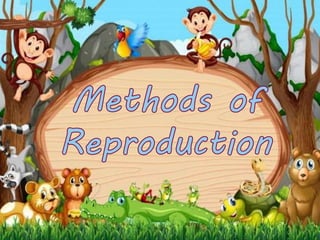Methods/Modes of reproduction by L.Znerual
•Download as PPTX, PDF•
0 likes•40 views
Sexual and Asexual Reproduction Internal and External reproduction
Report
Share
Report
Share

Recommended
Reproduction in organisms, Life cycle phases, Asexual and sexual reproduction, Events of sexual reproductionReproduction in organisms, Life cycle phases, Asexual and sexual reproduction...

Reproduction in organisms, Life cycle phases, Asexual and sexual reproduction...HARINATHA REDDY ASWARTHA
Recommended
Reproduction in organisms, Life cycle phases, Asexual and sexual reproduction, Events of sexual reproductionReproduction in organisms, Life cycle phases, Asexual and sexual reproduction...

Reproduction in organisms, Life cycle phases, Asexual and sexual reproduction...HARINATHA REDDY ASWARTHA
More Related Content
What's hot
What's hot (20)
Unit a biologicaldiversitynotes(asexual-sexual reproduction)

Unit a biologicaldiversitynotes(asexual-sexual reproduction)
Similar to Methods/Modes of reproduction by L.Znerual
Similar to Methods/Modes of reproduction by L.Znerual (20)
Grade 5 PPT_Science_Q2_W6_Methods of reproduction.ppt

Grade 5 PPT_Science_Q2_W6_Methods of reproduction.ppt
How Do Organisms Reproduce ? - Class 10 CBSE science (BIo)

How Do Organisms Reproduce ? - Class 10 CBSE science (BIo)
Recently uploaded
Mehran University Newsletter is a Quarterly Publication from Public Relations OfficeMehran University Newsletter Vol-X, Issue-I, 2024

Mehran University Newsletter Vol-X, Issue-I, 2024Mehran University of Engineering & Technology, Jamshoro
This presentation was provided by William Mattingly of the Smithsonian Institution, during the third segment of the NISO training series "AI & Prompt Design." Session Three: Beginning Conversations, was held on April 18, 2024.Mattingly "AI & Prompt Design: The Basics of Prompt Design"

Mattingly "AI & Prompt Design: The Basics of Prompt Design"National Information Standards Organization (NISO)
Recently uploaded (20)
Mixin Classes in Odoo 17 How to Extend Models Using Mixin Classes

Mixin Classes in Odoo 17 How to Extend Models Using Mixin Classes
Measures of Dispersion and Variability: Range, QD, AD and SD

Measures of Dispersion and Variability: Range, QD, AD and SD
Basic Civil Engineering first year Notes- Chapter 4 Building.pptx

Basic Civil Engineering first year Notes- Chapter 4 Building.pptx
Seal of Good Local Governance (SGLG) 2024Final.pptx

Seal of Good Local Governance (SGLG) 2024Final.pptx
Presentation by Andreas Schleicher Tackling the School Absenteeism Crisis 30 ...

Presentation by Andreas Schleicher Tackling the School Absenteeism Crisis 30 ...
Beyond the EU: DORA and NIS 2 Directive's Global Impact

Beyond the EU: DORA and NIS 2 Directive's Global Impact
Unit-V; Pricing (Pharma Marketing Management).pptx

Unit-V; Pricing (Pharma Marketing Management).pptx
Mattingly "AI & Prompt Design: The Basics of Prompt Design"

Mattingly "AI & Prompt Design: The Basics of Prompt Design"
Methods/Modes of reproduction by L.Znerual
- 3. • Organisms that reproduce asexually cannot develop much variety, because they are “copying” the original organism exactly. • requires only 1 parent and the offspring are an exact copy of the parent---a clone
- 5. Single-celled organisms (Amoeba, paramecium, euglena) which use asexual reproduction can do so simply by dividing into two equal halves.
- 6. • When conditions are good, such as plenty of water, food, right temperatures, etc., binary fission is a very effective way of producing many, many offspring. • For example, the cell of a Paramecium can divide, grow, and divide again in the space of 8 hours.
- 7. Hydra Budding offspring Cactus Budding an offspring grows out of the body of the parent.
- 8. Yeast - budding Budding In yeasts the cell does not divide equally in two halves; instead, there is a large mother cell and a smaller daughter cell.
- 9. Fragmentation In this form, the body of the parent breaks into distinct pieces, each of which can produce an offspring. Pieces of coral broken off in storms can grow into new colonies. A new starfish can grow from one detached arm.
- 10. Fragmentation- plant cuttings Some plants can grow from cutting them up and replanting them.
- 11. Green plants are quite sophisticated in their methods of asexual reproduction. Offspring may be produced by runners, bulbs, rhizomes or tubers.
- 12. Parthenogenesis is a form of asexual reproduction in which females produce eggs that develop without fertilization. Parthenogenesis is seen to occur naturally in some invertebrates, along with several fish, amphibians, and reptiles as well as in many plants. There are no known cases of parthenogenesis in mammals.
- 13. • Requiring 2 parents –male and female (egg & sperm) • The egg and sperm join (zygote) to form an entirely new organism • Offspring are different from the parent organism because
- 14. Requiring 2 parents (egg & sperm) Combining different genetic material
- 15. Pollination External Fertilization Internal Fertilization
- 16. Pollen is produced in the male organs of the flowers - anthers. Pollination occurs when pollen is transferred from the anthers to the female organs by wind or by animals. If the female stigma is receptive to a pollen grain, the pollen produces a pollen tube, which grows through the female tissue to the egg, where fertilization takes place by the sperm nucleus. Sexual Reproduction in Flowering Plants
- 17. • External fertilization usually requires a medium such as water, which the sperms can use to swim towards the egg cell. External fertilization usually occur in fish and amphibians. • The females lay the eggs in the water and the male squirts the sperm in the same area.
- 18. • Fertilization occurs within the female. • Internal fertilization occurs in mammals, insects, birds, reptiles. – Mammals (gorillas, lions, elephants, rats, zebras, and dolphins have live births) – Insects, birds, reptiles lay eggs
- 19. • •
- 20. • Asexual reproduction results in offspring that are genetically identical to the parent organism. • Sexual reproduction results in offspring that are genetically different from the parent organisms.